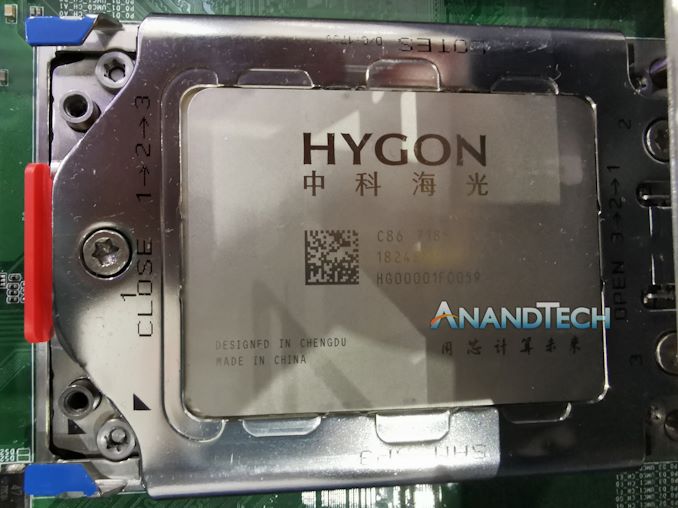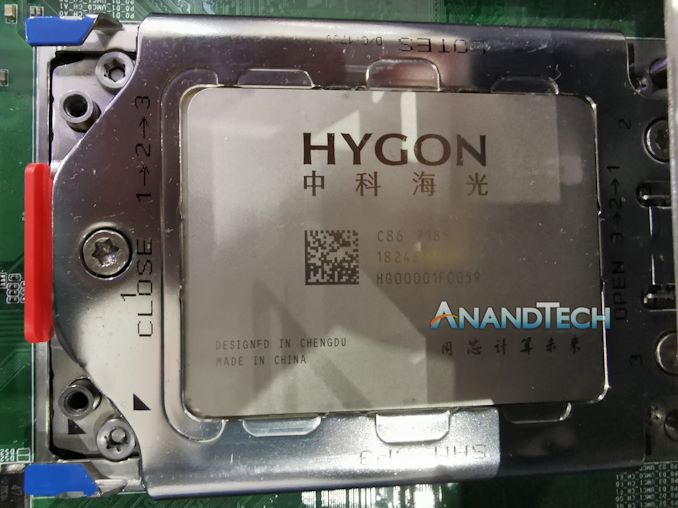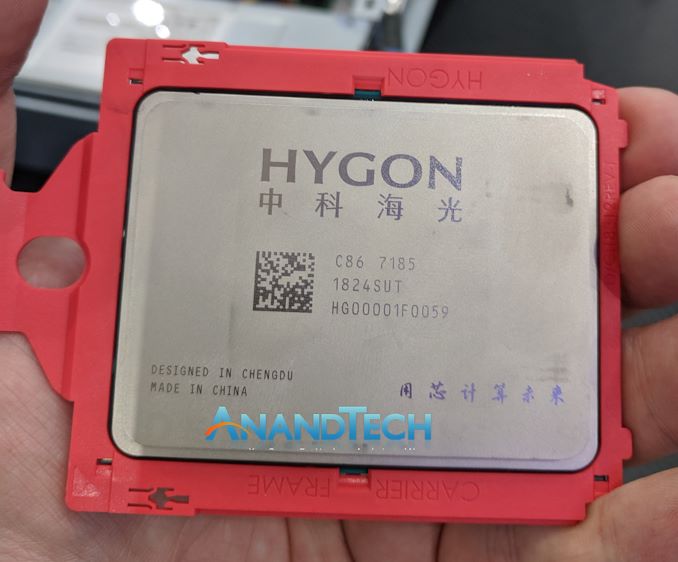Spotted at Computex: Let Bygones be Bygons, with a Sugon Hygon
by Ian Cutress on May 30, 2019 4:00 PM EST- Posted in
- CPUs
- AMD
- x86
- Enterprise
- Trade Shows
- EPYC
- Computex 2019
- Dhyana
- Hygon
- Sugon

Big credit to Patrick Kennedy from ServeTheHome for spotting this gem on the show floor, but it looks like if you want a Chinese branded EPYC CPU with some minor changes, it’s coming. Back in 2016, AMD and Hianjin Jaiguang Advanced Technology Investment Co. (THATIC) formed a joint venture (JV) to develop custom Zen-based processors just for the Chinese market. Within the JV, AMD would provide its Zen microarchitecture, whereas the rest of the SoC would be designed by the JV. AMD owns 49% of the company, while THATIC owns 51%. The first product out of that partnership is the Hugon Dhyana family of processors, and the first retailer with systems is Sugon.
There are lots of questions surrounding exactly what these CPUs are. A Weibo user from China has published a screenshot allegedly taken on one of Hugon Dhyana-based machines which reveals that the eight-core Dhyana 3185 features 768 KB L1 cache, 4 MB L2 cache, and 16 MB L3 cache, the same configuration as AMD’s low-end eight-core EPYC processors. They look like EPYC processors, but with different cryptography engines inside the chip. Differences beyond that are unknown, but it still uses the same packaging and the same socket as EPYC. Now with a visual image, we can tell another key significant difference – while the carrier for Threadripper is orange, and for EPYC is blue, with Hygon CPUs it is red. This is very important.
Other details about the CPU were not present – we found the CPU in a system being developed by one of the JV OEM partners. We’re working with that partner to hopefully get a system in for testing.
Interestingly enough, we got the bottom right of the CPU translated. A literal translation is
'Using Cores to Calculate The Future'
However, the second character used in the slogan is a homonym, which could be translated as:
'Using Passion to Calculate The Future'
For a Chinese CPU, the synergestic phrasing is very poetic.
| Want to keep up to date with all of our Computex 2019 Coverage? | ||||||
 Laptops |
 Hardware |
 Chips |
||||
| Follow AnandTech's breaking news here! | ||||||
Note, if anyone from Sugon or Hygon wants to get in touch to talk about a review, please email our CPU editor Dr. Ian Cutress: ian@anandtech.com













55 Comments
View All Comments
extide - Thursday, May 30, 2019 - link
I bet this works just like the MS/Sony deals. This is a semi-custom chip, using the Zen core, and their 3rd party encryption IP. I would imagine they want it to be fabbed in China but I don't think there are any fabs that can do small enough nodes to make this product so it would have to be GF?TSMC, and probably GF 14nm, like the regular ones.edzieba - Thursday, May 30, 2019 - link
If watercooled, one could plumb it with Tygon!Lord of the Bored - Friday, May 31, 2019 - link
And if it were in Ghostbusters, it'd be used by Egon!69369369 - Thursday, May 30, 2019 - link
This comments section:"REEEE MADE IN CHINA REEEEEEEEE"
GreenReaper - Thursday, May 30, 2019 - link
It is, though! It's even red - a blatant tip of the hat to AMD's overlords in Beijing.quadibloc - Friday, May 31, 2019 - link
Speaking of poetry... I notice the chip says that it was designed in Chengdu. That city used to have its name spelled in a lot of different ways in English. One of them was used by Samuel Taylor Coleridge.Yes, the disco palace built with the help of the Muse Terpsichore was named after the Chinese city of Chengdu... in the movie wherein said Muse was portrayed by the lovely Olivia Newton-John.
In Xanadu did Kublai Khan a stately pleasure dome decree...
quadibloc - Friday, May 31, 2019 - link
I see I am mistaken, although there is a Xanadu hotel in Chengdu to capitalize on the confusion I apparently have shared with others. Kublai Khan built his stately palace, with a movable pleasure hut, in Shengdu, which is a city in the Chinese region of Inner Mongolia; Changdu, on the other hand, is a city in Szechwan province, which is in the southern part of China, not the northern part.SeanNing - Friday, May 31, 2019 - link
Woa! What a surprise to meet someone interested in our culture here!I actually am a chinese, and I'm from Inner Mongolia Autonomous Region.
The palace you mentioned is called 忽必烈夏宫, 忽必烈 is Kublai Khan,夏means summer,宫is palace. It's also called 忽必烈行宫, which literally means Kublai Khan moving palace, but in fact, it isn't a movable hut ,the only thing moving is Kublai Khan himself.
When summer becomes hot, emperor travels to somewhere cool and pleasing, then build a palace there and enjoy his summer time there. So "moving palace" doesn't move, the emperor moves to the palace.
SeanNing - Friday, May 31, 2019 - link
The "Xanadu" you mentioned, is 上都, which literally means upper Capital.During Yuan Dynasty, there were two Capital, 上都(upper Capital) and 大都(big Capital).
上都(upper Capital) is in inner mongolia, and 上都(upper Capital) is also called 夏都(summer Capital). Because Kublai Khan spends his summer here.
大都(big Capital) is Beijing.
SeanNing - Friday, May 31, 2019 - link
Anyhow, this chip is assembled in Chengdu(in Szechwan), farrrrr away from my hometown.Hmmm, pity.